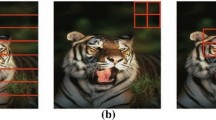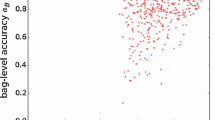Abstract
In multi-instance learning, the training examples are bags composed of instances without labels, and the task is to predict the labels of unseen bags through analyzing the training bags with known labels. A bag is positive if it contains at least one positive instance, while it is negative if it contains no positive instance. In this paper, a neural network based multi-instance learning algorithm named RBF-MIP is presented, which is derived from the popular radial basis function (RBF) methods. Briefly, the first layer of an RBF-MIP neural network is composed of clusters of bags formed by merging training bags agglomeratively, where Hausdorff metric is utilized to measure distances between bags and between clusters. Weights of second layer of the RBF-MIP neural network are optimized by minimizing a sum-of-squares error function and worked out through singular value decomposition (SVD). Experiments on real-world multi-instance benchmark data, artificial multi-instance benchmark data and natural scene image database retrieval are carried out. The experimental results show that RBF-MIP is among the several best learning algorithms on multi-instance problems.
Similar content being viewed by others
References
E. Alphonse S. Matwin (2004) ArticleTitleFiltering multi-instance problems to reduce dimensionality in relational learning Journal of Intelligent Information Systems 22 IssueID1 23–40 Occurrence Handle10.1023/A:1025876613117
Amar, R. A., Dooly, D. R., Goldman, S. A. and Zhang, Q.: Multiple-instance learning of real-valued data, In: Proceedings of the 18th International Conference on Machine Learning, pp. 3–10, Williamstown, MA, 2001. [http://www.cs.wustl.edu/~sg/multi-inst-data]
S. Andrews I. Tsochantaridis T. Hofmann (2003) Support vector machines for multiple-instance learning S. Becker S. Thrun K. Obermayer (Eds) Advances in Neural Information Processing Systems 15 MIT Press Cambridge, MA 561–568
Auer, P.: On learning from multi-instance examples: empirical evaluation of a theoretical approach, In: Proceedings of the 14th International Conference on Machine Learning, pp. 21–29, Nashville, TN, 1997.
P. Auer P. M. Long A. Srinivasan (1998) ArticleTitleApproximating hyper-rectangles: learning and pseudo-random sets Journal of Computer and System Sciences 57 IssueID3 376–388 Occurrence Handle10.1006/jcss.1998.1593 Occurrence Handle2000e:68080
C. M. Bishop (1995) Neural Networks for Pattern Recognition Oxford University Press New York
Blake, C., Keogh, E. and Merz, C. J.: UCI repository of machine learning databases. Department of Information and Computer Science, University of California, Irvine, CA, 1998. [http://www.ics.uci.edu/~mlearn/MLRepository.html]
A. Blum A. Kalai (1998) ArticleTitleA note on learning from multiple-instance examples Machine Learning 30 IssueID1 23–29 Occurrence Handle10.1023/A:1007402410823
Y. Chevaleyre J.-D. Zucker (2001) Solving multiple-instance and multiple-part learning problems with decision trees and decision rules. Application to the mutagenesis problem E. Stroulia S. Matwin (Eds) Lecture Notes in Artificial Intelligence 2056 Springer Berlin 204–214
A. P. Dempster N. M. Laird D. B. Rubin (1977) ArticleTitleMaximum likelihood from incomplete data via the EM algorithm Journal of the Royal Statistics Society, Series B 39 IssueID1 1–38 Occurrence Handle58 #18858
L. Raedt ParticleDe (1998) Attribute-value learning versus inductive logic programming: the missing links D. Page (Eds) Lecture Notes in Artificial Intelligence 1446 Springer Berlin 1–8
T. G. Dietterich R. H. Lathrop T. Lozano-Pérez (1997) ArticleTitleSolving the multiple-instance problem with axis-parallel rectangles Artificial Intelligence 89 IssueID1–2 31–71
D. R. Dooly S. A. Goldman S. S. Kwek (2001) Real-valued multiple-instance learning with queries N. Abe R. Khardon T. Zeugmann (Eds) Lecture Notes in Artificial Intelligence 2225 Springer Berlin 167–180
G. A. Edgar (1995) Measure, Topology, and Fractal Geometry Springer-Verlag Berlin
Gärtner, T., Flach, P. A., Kowalczyk, A. and Smola, A. J.: Multi-instance kernels, In: Proceedings of the 19th International Conference on Machine Learning, pp. 179–186, Sydney, Australia, 2002.
S. A. Goldman S. S. Kwek S. D. Scott (2001) ArticleTitleAgnostic learning of geometric patterns Journal of Computer and System Sciences 62 IssueID1 123–151 Occurrence Handle10.1006/jcss.2000.1723 Occurrence Handle2002e:68050
S. A. Goldman S. D. Scott (2003) ArticleTitleMultiple-instance learning of real-valued geometric patterns Annals of Mathematics and Artificial Intelligence 39 IssueID3 259–290 Occurrence Handle10.1023/A:1024671512350 Occurrence Handle2004j:68086
I. T. Jollife (1986) Principle Component Analysis Springer-Verlag New York
Kearns, M. J.: Efficient noise-tolerant learning from statistical queries, In: Proceedings of the 25th Annual ACM Symposium on Theory of Computing, pp. 392–401, San Diego, CA, 1993.
M. J. Kearns R. E. Schapire (1994) ArticleTitleEfficient distribution-free learning of probabilistic concepts Journal of Computer and System Sciences 48 IssueID3 464–497 Occurrence Handle10.1016/S0022-0000(05)80062-5 Occurrence Handle95m:68142
R. Lindsay B. Buchanan E. Feigenbaum J. Lederberg (1980) Applications of Artificial Intelligence to Organic Chemistry: The DENDRAL Project McGraw-Hill New York
P. M. Long L. Tan (1998) ArticleTitlePAC learning axis-aligned rectangles with respect to product distribution from multiple-instance examples Machine Learning 30 IssueID1 7–21 Occurrence Handle10.1023/A:1007450326753
O. Maron (1998) Learning from Ambiguity Department of Electronical Engineering and Computer Science, MIT Cambridge, MA
O. Maron T. Lozano-Pérez (1998) A framework for multiple-instance learning M. I. Jordan M. J. Kearns S. A. Solla (Eds) Advances in Neural Information Processing Systems 10 MIT Press Cambridge, MA 570–576
Maron, O. and Ratan, A. L.: Multiple-instance learning for natural scene classification, In: Proceedings of the 15th International Conference on Machine Learning, pp. 341–349, Madison, WI, 1998.
W. H. Press S. A. Teukolsky W. T. Vetterling B. P. Flannery (1992) Numerical Recipes in C: The Art of Scientific Computing EditionNumber2 Cambridge University Press New York
Ray, S. and Page, D.: Multiple instance regression, In: Proceedings of the 18th International Conference on Machine Learning, pp. 425–432, Williamstown, MA, 2001.
G. Ruffo (2000) Learning single and multiple decision trees for security applications Department of Computer Science, University of Turin Italy
D. E. Rumelhart G. E. Hinton R. J. Williams (1986) Learning internal representations by error propagation D. E. Rumelhart J. L. McClelland (Eds) Parallel Distributed Processing: Explorations in the Microstructure of Cognition NumberInSeriesVol. 1 MIT Press Cambridge, MA 318–362
Sebag, M. and Rouveirol, C.: Tractable induction and classification in first order logic, In: Proceedings of the 15th International Joint Conference on Artificial Intelligence, pp. 888–893, Nagoya, Japan, 1997.
Wang, J. and Zucker, J.-D.: Solving the multiple-instance problem: a lazy learning approach, In: Proceedings of the 17th International Conference on Machine Learning, pp. 1119–1125, San Francisco, CA, 2000.
Yang, C. and Lozano- Pérez, T.: Image database retrieval with multiple-instance learning techniques, In: Proceedings of the 16th International Conference on Data Engineering, pp. 233–243, San Diego, CA, 2000.
Q. Zhang S. A. Goldman (2002) EM-DD: an improved multiple-instance learning technique T. G. Dietterich S. Becker Z. Ghahramani (Eds) Advances in Neural Information Processing Systems 14 MIT Press Cambridge, MA 1073–1080
Zhang, Q., Yu, W., Goldman, S. A. and Fritts, J. E.: Content-based image retrieval using multiple-instance learning, In: Proceedings of the 19th International Conference on Machine Learning, pp. 682–689, Sydney, Australia, 2002.
M.-L. Zhang Z.-H. Zhou (2004) ArticleTitleImprove multi-instance neural network through feature selection Neural Processing Letters 19 IssueID1 1–10 Occurrence Handle10.1023/B:NEPL.0000016836.03614.9f
Z.-H. Zhou J. Wu W. Tang (2002) ArticleTitleEnsembling neural networks: many could be better than all Artificial Intelligence 137 IssueID1–2 239–263 Occurrence Handle1906477
Z.-H. Zhou M.-L. Zhang (2002) Neural networks for multi-instance learning AI Lab, Computer Science & Technology Department, Nanjing University China
Z.-H. Zhou M.-L. Zhang (2003) Ensembles of multi-instance learners N. Lavrač D. Gamberger H. Blockeel L. Todorovski (Eds) Lecture Notes in Artificial Intelligence 2837 Springer-Verlag Berlin 492–502
Zucker, J.-D. and Ganascia, J.-G.: Changes of representation for efficient learning in structural domains, In: Proceedings of the 13th International Conference on Machine Learning, pp. 543–551, Bary, Italy, 1996.
J.-D. Zucker J.-G. Ganascia (1998) Learning structurally indeterminate clauses D. Page (Eds) Lecture Notes in Artificial Intelligence 1446 Springer Berlin 235–244
Author information
Authors and Affiliations
Corresponding author
Rights and permissions
About this article
Cite this article
Zhang, ML., Zhou, ZH. Adapting RBF Neural Networks to Multi-Instance Learning. Neural Process Lett 23, 1–26 (2006). https://doi.org/10.1007/s11063-005-2192-z
Issue Date:
DOI: https://doi.org/10.1007/s11063-005-2192-z




